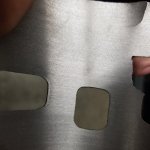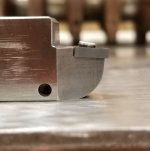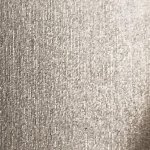My engine boring bar has a speed of 344rpm and a feed of 1-3/4" min. I have been using the inserts engine rebuilding supply shops sell which are generic to the many boring bar feeds and speeds out there as these inserts these places sell are all the same. The issue with using these inserts and my bar specs is they act more like a threading insert and not providing enough overlap ( currently 60 degree) which leaves very fine ridges through the cylinder. I was thinking a insert with a larger radius is what I need so I got on MSC to look at what they had and with so many inserts available I am a bit lost on what ones I should try. I believe the inserts I currently have are TPGH style. Any help getting me pointed in the right direction of recommend inserts would be great.
How to install the app on iOS
Follow along with the video below to see how to install our site as a web app on your home screen.
Note: This feature may not be available in some browsers.
You are using an out of date browser. It may not display this or other websites correctly.
You should upgrade or use an alternative browser.
You should upgrade or use an alternative browser.
Engine boring bar inserts
- Thread starter jl1132
- Start date
- Replies 23
- Views 4,423
Milland
Diamond
- Joined
- Jul 6, 2006
- Location
- Hillsboro, New Hampshire
Can you take a measurement from the center of the hole to the middle of a flat? This would be the radius used to define the insert size. Also, state the the thickness.
We have a member named Carbidebob who would be a good person to ask for advice.
We have a member named Carbidebob who would be a good person to ask for advice.
Can you take a measurement from the center of the hole to the middle of a flat? This would be the radius used to define the insert size. Also, state the the thickness.
We have a member named Carbidebob who would be a good person to ask for advice.
.127 is what I measure from the center of the hole to one of the flats. The thickness is .095. Not sure if it makes a difference but 60% of my work has interrupted cuts, 2 stroke cylinders. Thanks
Milland
Diamond
- Joined
- Jul 6, 2006
- Location
- Hillsboro, New Hampshire
.127 is what I measure from the center of the hole to one of the flats. The thickness is .095. Not sure if it makes a difference but 60% of my work has interrupted cuts, 2 stroke cylinders. Thanks
So it's a 1/4" IC (inscribed circle) insert, 3/32 thick.
Are the cylinders plated aluminum, or cast iron, or something else? And do you hone after boring, or use as-is?
So it's a 1/4" IC (inscribed circle) insert, 3/32 thick.
Are the cylinders plated aluminum, or cast iron, or something else? And do you hone after boring, or use as-is?[/QUOT
I have a power stroke hone, I always leave plenty of stock to hone because of the finish I am left with after boring with the insert and to make sure I am headed in the right direction with the profilometer as the material/hardness of cylinders I deal with vary and so do piston ring materials. I do bore out nickasil cylinders to install chromium molybdenum sleeves when the integrity of some cylinders are lost for big bore applications and cant not be nickasiled again. I will bore through the nickasil which is generally around .004 thick and then the aluminum for big bores that will not be sleeved and then nickasil is re-applied.
I was using the diamond lap on this boring bar to sharpen brazed carbide bits but the lap is pretty well kicked as are the laps on my other 4 bars. Figured I would try go the insert tool holder route as I can buy 4 of those for the price of one diamond lapping wheel.
Milland
Diamond
- Joined
- Jul 6, 2006
- Location
- Hillsboro, New Hampshire
Good info. I do think Carbidebob is the person who could really help.
eKretz
Diamond; Mod Squad
- Joined
- Mar 27, 2005
- Location
- Northwest Indiana, USA
If your speed and feed numbers are correct you are running a feed of about .005" per rev and the insert nose radius looks to be around 1/32" if that's a 1/4" IC insert so it should be producing a surface that's pretty smooth to the touch. You might want to confirm that your RPM and feed are where you think they are.
Other than that, how much stock are you leaving for honing? It shouldn't take more than a few thousandths of an inch to clean up the tool marks at that nose radius and feed.
Other than that, how much stock are you leaving for honing? It shouldn't take more than a few thousandths of an inch to clean up the tool marks at that nose radius and feed.
If your speed and feed numbers are correct you are running a feed of about .005" per rev and the insert nose radius looks to be around 1/32" if that's a 1/4" IC insert so it should be producing a surface that's pretty smooth to the touch. You might want to confirm that your RPM and feed are where you think they are.
Other than that, how much stock are you leaving for honing? It shouldn't take more than a few thousandths of an inch to clean up the tool marks at that nose radius and feed.
That is the feed and speed according to the factory manual, not sure if you saw them but posted a couple pictures of the finish.
I usually leave. 005 to hone out incase a cylinder wants to get away from me, like a Subaru block which you have to dwell like crazy on/open up the bottom first and then set/watch stroke length. I also like to think I enjoy chasing the profilometer around.
I have other bars that are multiple feed and speed which I can produce a super fine finish with but seeing if I can get this one diaed in better as I've dedicated it for the small cylinder stuff. Thanks
eKretz
Diamond; Mod Squad
- Joined
- Mar 27, 2005
- Location
- Northwest Indiana, USA
Yeah I saw them, can't really judge finish by a picture though of course. I guess I'm not sure of what you're expecting to accomplish with your insert change. If you're leaving .005" for honing you may be better off with a little coarser finish anyway as it will be quicker to come out to size during honing. You are completely removing the bored finish with the hone so what it looks like before it is honed is not too critical.
Limy Sami
Diamond
- Joined
- Jan 7, 2007
- Location
- Norfolk, UK
Silly point / just a thought time
Check that the feed gears in that boring bar have been put in ''the right way round'' and it is feeding at the rate stated (according to the OPs data it should be <> 0.005'' per rev)
Check that the feed gears in that boring bar have been put in ''the right way round'' and it is feeding at the rate stated (according to the OPs data it should be <> 0.005'' per rev)
Milland
Diamond
- Joined
- Jul 6, 2006
- Location
- Hillsboro, New Hampshire
Yeah I saw them, can't really judge finish by a picture though of course. I guess I'm not sure of what you're expecting to accomplish with your insert change. If you're leaving .005" for honing you may be better off with a little coarser finish anyway as it will be quicker to come out to size during honing. You are completely removing the bored finish with the hone so what it looks like before it is honed is not too critical.
I would agree with this. Especially if you're not getting chatter when passing over the port windows, I'd say you're doing well and just get on with the honing.
slowmotion
Cast Iron
- Joined
- Mar 31, 2013
- Location
- Danville Virginia
I agree that your existing insert looks like 1/32. At .005" ipm it should be fairly smooth. I bore smaller diameter cylinders (mostly outboard 2 strokes or Harley's) with a 1/64 radius at .007" ipm and leave only .003" to hone with no problem. I think if you go with a larger radius you might begin to see chatter, especially with an interrupted cut. Subaru's in VT? Who'da thunk it?
Turbowerks
Cast Iron
- Joined
- Nov 9, 2018
- Location
- Windom
How big is your bore? I used to do these on a f2 rottler bar with a small bore head on it , could never get a ‘smooth finish ‘ bar didn’t turn fast enough for inserts. All the auto supply companies sell the insert holders but few are optimized for the speeds available.
On my f84 machine i can speed up the spindle and set the feed independently , i can bore a cylinder wit a very fine finish but as Kretz said its much easier to hone a slightly rough bore to size as long as you leave stock. On a 3 inch bare with inserts im in the 700-900 rpm and feed at .005-.010 ipr almost like chrome on cast
When I find it I don’t need it
When I need it I can’t find it!
On my f84 machine i can speed up the spindle and set the feed independently , i can bore a cylinder wit a very fine finish but as Kretz said its much easier to hone a slightly rough bore to size as long as you leave stock. On a 3 inch bare with inserts im in the 700-900 rpm and feed at .005-.010 ipr almost like chrome on cast
When I find it I don’t need it
When I need it I can’t find it!
CarbideBob
Diamond
- Joined
- Jan 14, 2007
- Location
- Flushing/Flint, Michigan
Oh my I do cringe to see that screw in that insert but works sort of.
Height over the triangle? Top view of the bar as oriented in cut?
These tell you rad size and expected cusp.
Handy easily measured triangle dims below. Between the two they tell you the IC and the radius size.
The height is called the "A" dim and the width is called the "B" dimension.
Tell me what they are checked with a mic or calipers.
This is not a TPGH. TNGA
Bob
Height over the triangle? Top view of the bar as oriented in cut?
These tell you rad size and expected cusp.
Handy easily measured triangle dims below. Between the two they tell you the IC and the radius size.
The height is called the "A" dim and the width is called the "B" dimension.
Tell me what they are checked with a mic or calipers.
This is not a TPGH. TNGA
Bob
Attachments
Oh my I do cringe to see that screw in that insert but works sort of.
Height over the triangle? Top view of the bar as oriented in cut?
These tell you rad size and expected cusp.
Handy easily measured triangle dims below. Between the two they tell you the IC and the radius size.
The height is called the "A" dim and the width is called the "B" dimension.
Tell me what they are checked with a mic or calipers.
This is not a TPGH. TNGA
Bob

Height is .353 and width is .396 Thanks.
CarbideBob
Diamond
- Joined
- Jan 14, 2007
- Location
- Flushing/Flint, Michigan
Height is .353 and width is .396 Thanks.
Strange. Are the sides of the insert ground? What size is the hole?
Milland
Diamond
- Joined
- Jul 6, 2006
- Location
- Hillsboro, New Hampshire
Strange. Are the sides of the insert ground? What size is the hole?
Hi Bob, those numbers are pretty close to what I'd expect for a 1/4" I.C. and a 1/32 corner radius. And he's already confirmed the I.C. and thickness (3/32")
Larry Dickman
Titanium
- Joined
- Jan 30, 2014
- Location
- Temecula, Ca
can you get diamond inserts for it?
Similar threads
- Replies
- 8
- Views
- 668
- Replies
- 35
- Views
- 3K





